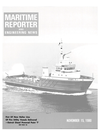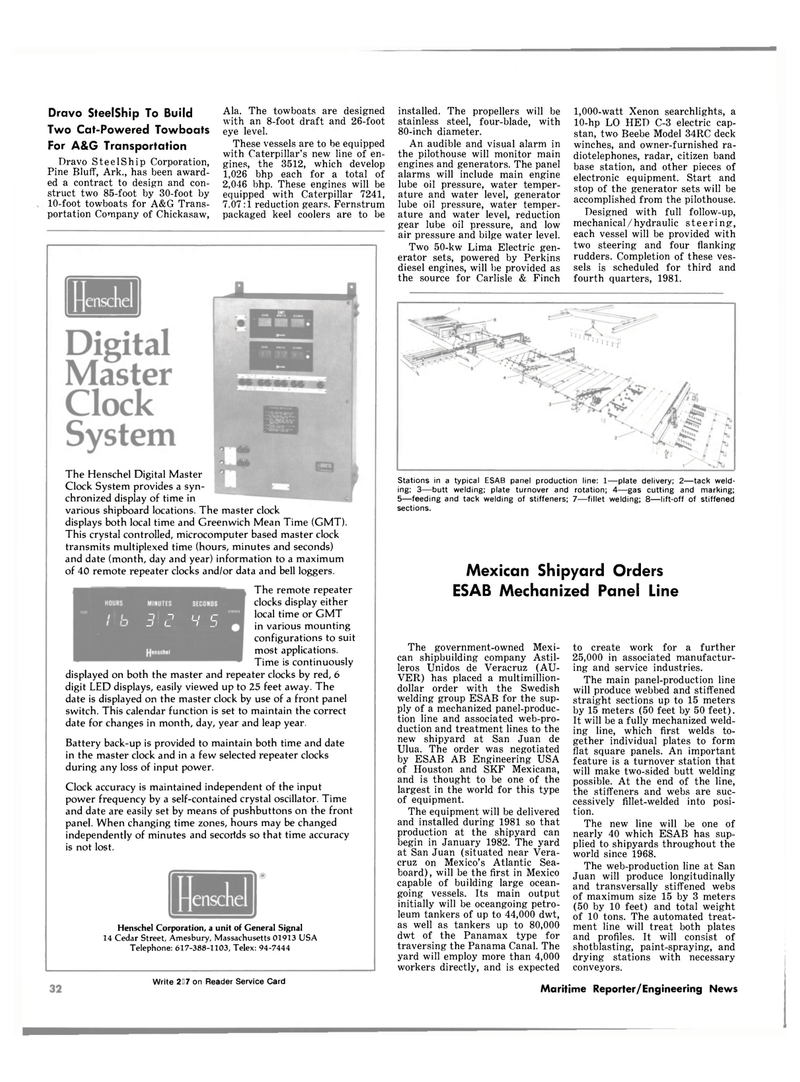
Page 30: of Maritime Reporter Magazine (November 15, 1980)
Read this page in Pdf, Flash or Html5 edition of November 15, 1980 Maritime Reporter Magazine
Dravo SteelShip To Build
Two Cat-Powered Towboats
For A&G Transportation
Dravo SteelShip Corporation,
Pine Bluff, Ark., has been award- ed a contract to design and con- struct two 85-foot by 30-foot by 10-foot towboats for A&G Trans- portation Company of Chickasaw,
Ala. The towboats are designed with an 8-foot draft and 26-foot eye level.
These vessels are to be equipped with Caterpillar's new line of en- gines, the 3512, which develop 1,026 bhp each for a total of 2,046 bhp. These engines will be equipped with Caterpillar 7241, 7.07:1 reduction gears. Fernstrum packaged keel coolers are to be
J 1 -i i- V 5
The Henschel Digital Master
Clock System provides a syn- chronized display of time in various shipboard locations. The master clock displays both local time and Greenwich Mean Time (GMT).
This crystal controlled, microcomputer based master clock transmits multiplexed time (hours, minutes and seconds) and date (month, day and year) information to a maximum of 40 remote repeater clocks and/or data and bell loggers.
The remote repeater clocks display either local time or GMT in various mounting configurations to suit most applications.
Time is continuously displayed on both the master and repeater clocks by red, 6 digit LED displays, easily viewed up to 25 feet away. The date is displayed on the master clock by use of a front panel switch. This calendar function is set to maintain the correct date for changes in month, day, year and leap year.
Battery back-up is provided to maintain both time and date in the master clock and in a few selected repeater clocks during any loss of input power.
Clock accuracy is maintained independent of the input power frequency by a self-contained crystal oscillator. Time and date are easily set by means of pushbuttons on the front panel. When changing time zones, hours may be changed independently of minutes and secortds so that time accuracy is not lost.
Henschel Corporation, a unit of General Signal 14 Cedar Street, Amesbury, Massachusetts 01913 USA
Telephone: 617-388-1103, Telex: 94-7444 installed. The propellers will be stainless steel, four-blade, with 80-inch diameter.
An audible and visual alarm in the pilothouse will monitor main engines and generators. The panel alarms will include main engine lube oil pressure, water temper- ature and water level, generator lube oil pressure, water temper- ature and water level, reduction gear lube oil pressure, and low air pressure and bilge water level.
Two 50-kw Lima Electric gen- erator sets, powered by Perkins diesel engines, will be provided as the source for Carlisle & Finch 1,000-watt Xenon searchlights, a 10-hp LO HED C-3 electric cap- stan, two Beebe Model 34RC deck winches, and owner-furnished ra- diotelephones, radar, citizen band base station, and other pieces of electronic equipment. Start and stop of the generator sets will be accomplished from the pilothouse.
Designed with full follow-up, mechanical / hydraulic steering, each vessel will be provided with two steering and four flanking rudders. Completion of these ves- sels is scheduled for third and fourth quarters, 1981.
Stations in a typical ESAB panel production line: 1—plate delivery; 2—tack weld- ing; 3—butt welding; plate turnover and rotation; 4—gas cutting and marking; 5—feeding and tack welding of stiffeners; 7—fillet welding; 8—lift-off of stiffened sections.
Mexican Shipyard Orders
ESAB Mechanized Panel Line
The government-owned Mexi- can shipbuilding company Astil- leros Unidos de Veracruz (AU-
VER) has placed a multimillion- dollar order with the Swedish welding group ESAB for the sup- ply of a mechanized panel-produc- tion line and associated web-pro- duction and treatment lines to the new shipyard at San Juan de
Ulua. The order was negotiated by ESAB AB Engineering USA of Houston and SKF Mexicana, and is thought to be one of the largest in the world for this type of equipment.
The equipment will be delivered and installed during 1981 so that production at the shipyard can begin in January 1982. The yard at San Juan (situated near Vera- cruz on Mexico's Atlantic Sea- board), will be the first in Mexico capable of building large ocean- going vessels. Its main output initially will be oceangoing petro- leum tankers of up to 44,000 dwt, as well as tankers up to 80,000 dwt of the Panamax type for traversing the Panama Canal. The yard will employ more than 4,000 workers directly, and is expected to create work for a further 25,000 in associated manufactur- ing and service industries.
The main panel-production line will produce webbed and stiffened straight sections up to 15 meters by 15 meters (50 feet by 50 feet).
It will be a fully mechanized weld- ing line, which first welds to- gether individual plates to form flat square panels. An important feature is a turnover station that will make two-sided butt welding possible. At the end of the line, the stiffeners and webs are suc- cessively fillet-welded into posi- tion.
The new line will be one of nearly 40 which ESAB has sup- plied to shipyards throughout the world since 1968.
The web-production line at San
Juan will produce longitudinally and transversally stiffened webs of maximum size 15 by 3 meters (50 by 10 feet) and total weight of 10 tons. The automated treat- ment line will treat both plates and profiles. It will consist of shotblasting, paint-spraying, and drying stations with necessary conveyors. 44 Write 271 on Reader Service Card Maritime Reporter/Engineering News

 29
29

 31
31
